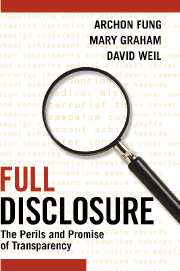Book contents
- Frontmatter
- Dediaction
- Contents
- List of Figures and Tables
- Preface
- 1 Governance by Transparency
- 2 An Unlikely Policy Innovation
- 3 Designing Transparency Policies
- 4 What Makes Transparency Work?
- 5 What Makes Transparency Sustainable?
- 6 International Transparency
- 7 Toward Collaborative Transparency
- 8 Targeted Transparency in the Information Age
- Appendix: EighteenMajor Cases
- Notes
- Bibliography
- Index
5 - What Makes Transparency Sustainable?
Published online by Cambridge University Press: 27 July 2009
- Frontmatter
- Dediaction
- Contents
- List of Figures and Tables
- Preface
- 1 Governance by Transparency
- 2 An Unlikely Policy Innovation
- 3 Designing Transparency Policies
- 4 What Makes Transparency Work?
- 5 What Makes Transparency Sustainable?
- 6 International Transparency
- 7 Toward Collaborative Transparency
- 8 Targeted Transparency in the Information Age
- Appendix: EighteenMajor Cases
- Notes
- Bibliography
- Index
Summary
We have seen this pattern repeatedly: Enron and WorldCom accounting scandals trigger Sarbanes-Oxley reporting reforms. The chemical catastrophe in Bhopal, India triggers toxic pollution reporting in the United States. A rash of deaths from microbes in drinking water triggers a national water safety disclosure. A wave of SUV-related deaths triggers a rollover rating system.
Transparency systems are often tacked together in times of crisis. They emerge out of high-stakes political debates driven by newly perceived needs for public action. As a result, they often begin as half-baked compromises, missing crucial elements and suffering from flawed design. After the crisis passes fromthe headlines, the transparency system is typically neglected and necessary improvements go unaddressed.
It is not particularly surprising that transparency systems fail, for two reasons. First, transparency typically imposes costs on a small group of information disclosers in the hope of generating benefits for a large and dispersed class of information users. Since the stakes are higher for the potential disclosers, they dominate the political processes that shape transparency systems over time. Second, transparency conflicts with other core values – the need to protect trade secrets and personal privacy, for example – that can tip the balance toward keeping information confidential. Under these circumstances, it is remarkable that some relatively robust targeted transparency systems actually emerge from legislative deliberations and survive.
In fact, many targeted transparency systems that are flawed in the beginning manage to improve over time and ultimately deliver the public benefits that policymakers hoped for. This chapter investigates why some transparency policies gain accuracy, scope, and use over time, becoming, in our terms, sustainable, while others degenerate into costly exercises in paper pushing or excuses for avoiding real action.
CRISIS DRIVES FINANCIAL DISCLOSURE IMPROVEMENTS
The accounting scandals at Enron, Tyco,WorldCom, and other large corporations that rocked capital markets in 2001–2002 demonstrate that the systemof corporate financial disclosure in theUnited States – the nation's most respected and most mature targeted transparency system – is far from perfect. Yet few would dispute that corporate financial disclosure has improved markedly in scope, accuracy, and usefulness during the seven decades since its adoption. Improvement has not followed a smooth and continuous path, however. Instead, it has advanced by fits and starts, driven by the push and pull of conflicting investor and corporate interests.
- Type
- Chapter
- Information
- Full DisclosureThe Perils and Promise of Transparency, pp. 106 - 126Publisher: Cambridge University PressPrint publication year: 2007
- Creative Commons
- This content is Open Access and distributed under the terms of the Creative Commons Attribution licence CC-BY-NC 4.0 https://creativecommons.org/cclicenses/



